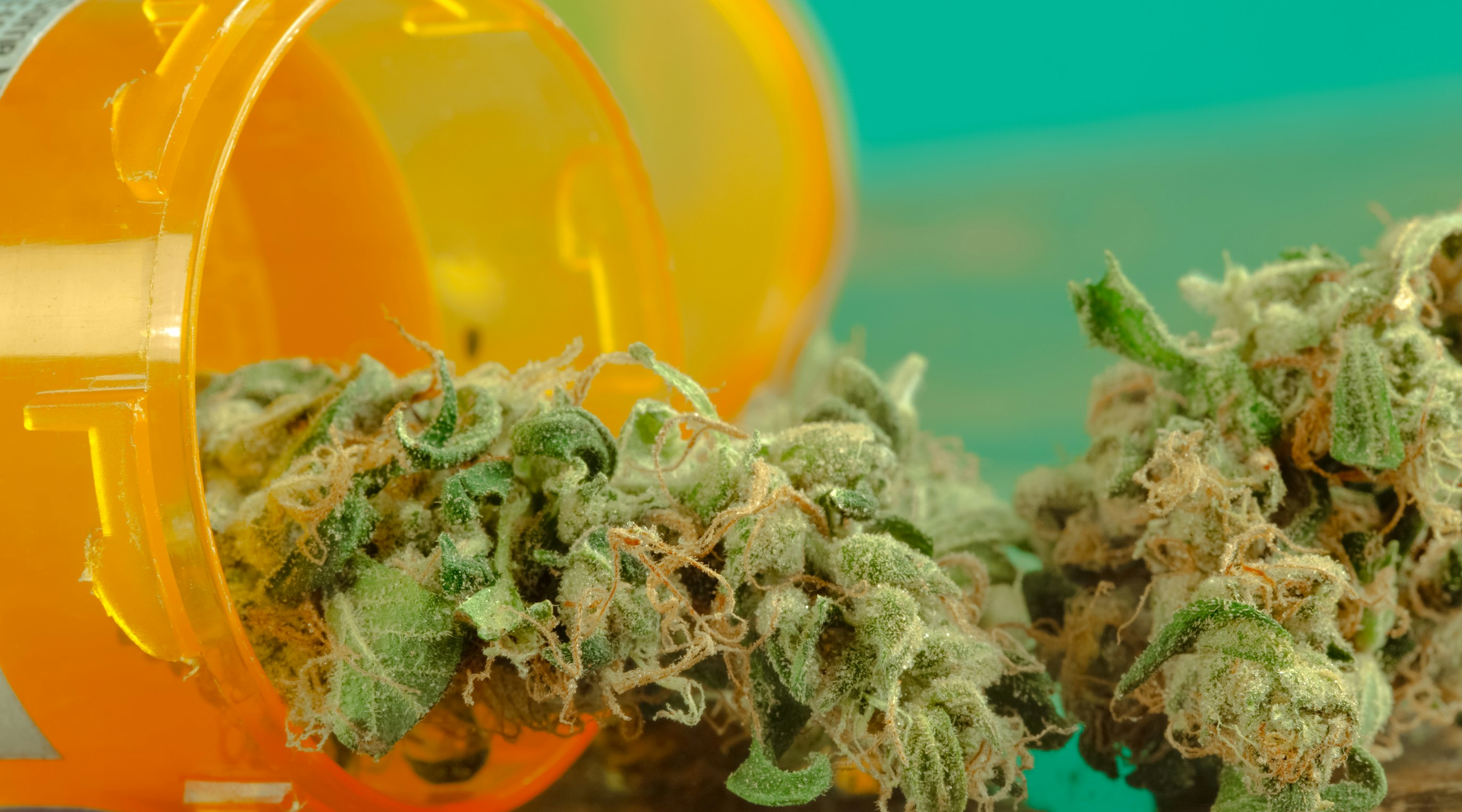The health benefits of terpenes and cannabinoids
8 min read
Lucy MacKinnon
Contents
Considering both terpenes and cannabinoids are secreted from the same part of the medical cannabis plant, it is unsurprising their associated effects and potential therapeutic benefits may be extremely similar.
Housed in the tiny trichomes that coat the surface of cannabis buds, cannabinoids like CBD and terpenes like Myrcene are produced by female cannabis plants in a potent resin. These minuscule orbs of resin give cannabis its crystal-like encrusted appearance, and they can be extracted from the plant to be used in the manufacturing of cannabis-based products.
Often overshadowed by their more famous cannabinoid roommates, CBD and THC, cannabis terpenes are also believed to contribute towards the plant's therapeutic value, however not as dramatically due to their lower concentrations.
In this article, we are going to find out what research says about the potential health benefits of terpenes and cannabinoids.
Terpenes cannabinoids benefits
Following the initial discovery of terpenes during the 1800s, now more than 20,000 different terpenes have been identified to exist naturally within plants amongst a variety of species. Most commonly known for their use in creating essential oils, terpenes and their associated benefits are utilised across the world to promote well-being. This is also true in the case of cannabis.
The Cannabis Sativa plant alone produces at least 150 different terpenes, each of which is thought to have the possible ability to impose certain effects on humans. Studies involving cannabis terpenes such as Myrcene, Pinene, Linalool, Caryophyllene, Citronellol, and Limonene have demonstrated that terpenes may offer therapeutic or medical benefits to human health.
Myrcene is believed to be the most prominent aroma component in the cannabis (as an entire species) terpene profile, and in some Indica strains, it can compromise up to 65% of the plant's total terpene count. This compound has been shown that it very well may contribute towards the anti-inflammatory and pain relieving qualities of medical cannabis.
Much like Myrcene, Caryophyllene has been shown to have high pharmaceutical potential, and may help pain and inflammation responses when administered. Typically found in higher concentrations in THC dominant strains, Caryophyllene’s medicinal properties have been found to benefit patients with Crohn's disease and Inflammatory Bowel Disease.
Cannabis strains that contain high concentrations of CBD are associated with having higher levels of the terpene Linalool, which can also be found in lavender and cinnamon. Linalool has also been shown to have anti-inflammatory properties, as well as being an anxiolytic and analgesic compound, which makes its application popular in cases of insomnia, arthritis, and depression or anxiety.
Both forms of Pinene, Alpha and Beta, are also present in the cannabis plant and are shown to relieve inflammation. These terpenes have also been investigated in the treatment of bronchitis and asthma due to their efficacy as a bronchodilator.
Limonene and Citronellol are frequently used in cosmetic or cleaning products due to their fresh-scented aromas, but they are also important terpenes within cannabis. Whilst limonene has been shown to display antifungal and antibacterial potential and has exhibited positive effects on possibly reducing tumours in animal studies, citronellol has antiseptic properties and is commonly used in the treatment of skin disorders.
Cannabinoids and their benefits
Together, CBD and THC make up the highest concentration of all chemical compounds in cannabis plants and so, they are believed to have the largest influence on the effects cannabis may have on humans.
For centuries (even millennia), there has been a vast amount of health benefits that have been anecdotally attributed to medical cannabis as well as its main active chemicals. But, just as our knowledge of human anatomy and physiology is constantly evolving, so is our understanding of how cannabinoids and other cannabis compounds interact with the body.
Studies into the relationship between cannabinoids and pain management have discovered THC may relieve the sensation of pain by tricking the brain’s reward system. This psychoactive compound has also demonstrated potential benefits for patients with appetite disorders, as THC is thought to trigger the hunger response and was found to improve the maintenance of stable weight in a study involving patients living with HIV/AIDS.
Low doses of THC have been seen to increase the extinction rate of traumatic memories in patients with PTSD. Whilst data from patients suffering from sleep disorders is still in its early stages, medical cannabis containing THC and CBD is associated with ensuring a deeper and more sound sleep.
CBD has also been thoroughly investigated, and scientists have now discovered possible anti-inflammatory and antioxidative effects associated with this compound. In the presence of CBD, the human body has been observed to be more effective in reducing or regulating oxidative stress and inflammation, two of the main side effects or causal factors in Alzheimer’s Disease.
Researchers have also found that the non-psychoactive cannabinoid CBD has the potential to be safe and effective in the treatment of rare forms of epilepsy, and has since been approved for this use around the globe. In the UK, this treatment is licensed and approved by the NHS, under the name Epidyolex.
From physical to mental health, cannabinoids have been shown to positively influence a variety of different side effects. However, like most other chemicals in medications, abuse, or misuse of cannabinoids can be dangerous and lead to health complications. Therefore, it is imperative to take medical cannabis as directed by your doctor or clinician.
The entourage effect
In combination with another group of cannabis chemicals called flavonoids, terpenes and cannabinoids work together synergistically to give an experience researchers call ‘the entourage effect’. It is theorised that when all three components are present, they enhance or amplify the possible therapeutic benefits or effects that can be experienced when taking medical cannabis.
In order for the entourage effect to be achieved, every type of flavonoid, terpene, and cannabinoid that naturally occurs in the plant is required. Full spectrum and whole plant cannabis products contain the entire plant profile of the plants they originate from, and for this reason, are most likely to induce the entourage effect.
On the other hand, broad-spectrum and isolate products are not associated with this experience because they contain only a few, or one individual cannabis component, respectively.
Methods of administration
Cannabinoids and terpenes can enter the system in a variety of ways; they can be inhaled by vaping cannabis flower or cannabis extracts; ingested in edible or tablet form; administered sublingually via cannabis oils or absorbed topically after being applied to the skin.
The most rapid form of cannabinoid and terpene delivery is inhalation and sublingual administration. When inhaled, cannabis compounds filter through the lungs and into the bloodstream, where they quickly reach cannabinoid receptors in the brain. Similarly, cannabis taken sublingually bypasses the digestive system. Instead, it is absorbed by the blood vessels that line the mouth, to be carried by the blood into the brain.
It takes a considerably longer amount of time for these same compounds to reach and interact with the ECS receptors when they have been ingested in edible form. This is because terpenes, cannabinoids, and other chemical compounds first have to pass through the digestive system, followed by the liver, where they are eventually filtered into the bloodstream. When ingested, due to the lengthy commute faced by cannabinoids and terpenes, it can take anywhere between thirty minutes and two hours for patients to feel any influence or possible benefits of medicinal cannabis.
Conclusion
Understanding the dynamics of terpenes and cannabinoids, and how they interact on a molecular level, is key to understanding the effects medicinal cannabis may have on our bodies. The entourage effect is especially important to consider when looking for a product that has the desired therapeutic effects and benefits. Depending on the desired outcome, different combinations of terpenes and cannabinoids may be needed to achieve this.
Always keep in mind that it is essential to consult with a doctor that is qualified and registered to prescribe medical cannabis before beginning to take any type of product. By doing so, you can ensure you are using the correct form and dose of cannabis for your individual needs.
Releaf understands the importance of medical cannabis in treating various medical conditions. With our tailored monthly packages, specialist consultations for medical cannabis, and a unique medical cannabis card for protection, you can access the treatment you need without worrying about the stigma.
Share article
Did you like this article?
It is important to seek medical advice before starting any new treatments. The patient advisors at Releaf are available to provide expert advice and support. Alternatively, click here to book a consultation with one of our specialist doctors.
Elevate your wellness with medical cannabis
Get comprehensive care, convenience, and confidence with an all-in-one treatment plan.
Am I eligible?Authors
With five years of journalism and healthcare content creation under her belt, Lucy strives to improve medical cannabis awareness and access in the UK by producing high quality, credible content.
Editorial Policy
All of our articles are written by medical cannabis experts, guided by strict sourcing guidelines, and reference peer-reviewed studies and credible academic research. Our expert clinical team and compliance specialists provide valuable insights to ensure accuracy when required. Learn more in our editorial policy.
Need more help?










